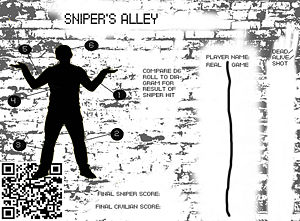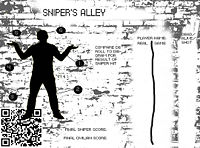Sniper's Alley
| Sniper's Alley | |
|---|---|

| |
| Designer: | Ben Eaton |
| Year: | unknown |
| Players: | 5-20 |
| Stuff required: | binoculars, paper, sticky tape, bibs, blue hats, two phones, 2 plastic bags per player, score sheet, marker pens and a six sided dice (d6) |
| Crew required: | One game runner, two if large numbers |
| Preparation: | 15 minutes. |
| Time required: | depending on how big the space and how big the group but upwards of 30min, plus ten minutes for scoring. |
| Place required: | a long busy street, a large open square, a busy park, a city block, anywhere with lots of places to duck to hide and nooks and crannies. |
| Activities: | Spying, running, hiding, sneaking |
| This is an untested game. Its rules are written, but it hasn't been tested out yet. | |
| This game is made available under an Attribution-Noncommercial Creative Commons licence. (What does this mean?) | |
Sniper's alley is a co-op and a versus game of snipers with binoculars, civilians trying to get home and the human shields trying to protect them.
Setup
The game is played in three teams: the sniper, the civilians, the human shields. For every 5 civilians appoint 1 human shield, and for every ten civilians appoint 1 sniper. Eg: a play group of 15 would generate: 1 sniper, 2 human shields and 12 players.
Each civilian fills in a character sheet marking their chosen name (preferably something monosyllabic and striking Eg: CAT, FAD etc...) and marks their appointed name largely on two pieces of paper. These are sellotaped to their front and back so the words are clearly visible. They are each given two shopping bags full of news paper to bulk them out.
The human shields are given blue bibs and blue hats and write a number on their bib: 1, 2, etc.
Whilst all the prep is going on the sniper leaves to get into position and have a bit of a scout.
The Game Runner supervises all this as well as clearly marking out the start zone and safety zone that the civilians are aiming for.
Game
The aim of the game for the civilians is to get to the safety zone, as marked out and clearly declared at the beginning of the game, carrying as much of their shopping with them as possible. For the sniper it is to get as many points as possible by ‘shooting’ the civilians. The game ends when all the remaining civilians who can have either crossed the finish line, in which case the points are tallied up to decide the winner, or the sniper has ‘shot’ all the civilians. A win for the civilians is a win for the human shields.
The game begins when the game runner calls the sniper. From this point on the game is live. The game runner and the sniper must stay in contact at all times.
The sniper uses his binoculars to spot and take 'shots' at the civilians.
Shooting
When the sniper sees a civilian and can read the word written on their front or back (lets say in this example its CAT) they are considered to be in his sights. To take a shot he must say the following phrase to the game runner: “BANG: CAT”. The game runner rolls his six sided dice
The game runner shouts out the name called by the sniper as well as the number of the dice roll (or he or she can reference the chart and shout out the result of the hit for faster reactions)
The player must respond appropriately:
- An arm hit means they can no longer carry a bag in that arm and must drop it.
- A leg hit means they can no longer walk on that leg.
- A second leg hits means they can no longer walk and must be carried.
- A head or body hit means that they are dead and must drop their bags where they stand.
If a player is hit and survives he or she must cross out clearly a letter of their name so the sniper has to spot them fully again to be able to call their new name out (using the same example he would have to call: "BANG: C-T" if the player had crossed out the A of CAT)
Human Shields
The human shields must protect and work with the civilians to get them to safety.
A sniper can ‘shoot’ a human shield but at the great cost of deducting 4 points from their score. To do so they must declare: “ BANG: BLUE-1(or relevant number)” the same rules for determining the nature of the hit apply.
If the sniper is uncertain or falters in declaring the name of their target having shouted “BANG” it is automatically considered that they shot a human shield in their haste and damage is worked out with d6 by the game runner, and points deducted accordingly
Spotting
Civilians and human shields can work together to ‘spot’ the sniper, but only the human shields can officially challenge their position. When they think they have spotted the sniper they call to the game runner: “SNIPER: and declare the position”. The game runner verifies this with the sniper, and if they have been spotted there is a 15 second amnesty whilst the sniper repositions during which time no shooting can occur. This is monitored by the game runner who declares the time to be over both down the phone to the sniper and to the civilian players.
Scoring
Once all the remaining civilians who are able have crossed into the safe area:
- They score 1 point per survivor and 1 point per pair of bags brought into the safe zone.
- The sniper scores 2 points per civilian killed and no points for injury.
- 4 points are deducted per human shield shot
The game's winner is the team with the most points. A win for the civilians is a win for the human shields.
If any civilians are caught breaking the rules of their injuries the game runner can declare them as having died from their wounds and the points are allocated to the sniper accordingly.
The point system tips clearly after a certain point in such a way that the only way for the civilians to win is to force the sniper to make a mistake and fire on the human shield and so requires some strategy and inventiveness on their part. And equally it is crucial for them to carry as many bags as possible across the finish line in order to tip the score in their favour enough, so some daring is required from them to ensure they have collected all of their fallen or injured comrades bags, as well as helping those less able cross the finish line.
Handouts
- reference sheet for dice rolls and player names in sniper's alley
